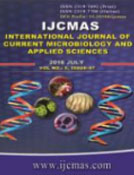


 National Academy of Agricultural Sciences (NAAS)
National Academy of Agricultural Sciences (NAAS)

|
PRINT ISSN : 2319-7692
Online ISSN : 2319-7706 Issues : 12 per year Publisher : Excellent Publishers Email : editorijcmas@gmail.com / submit@ijcmas.com Editor-in-chief: Dr.M.Prakash Index Copernicus ICV 2018: 95.39 NAAS RATING 2020: 5.38 |
The objective of the study was to describe the pattern of bacterial isolates from the blood cultures in intensive care units of our institute and to determine their antibiotic sensitivity, so that the study can provide guidelines for choosing an effective antibiotic therapy in cases of septicaemia. In this prospective study 462 blood samples collected from clinically suspected cases of septicemia received over a period of one year. The isolates were identified by standard biochemical tests and antimicrobial susceptibility testing determined by National Committee for Clinical Laboratory Standards (NCCLS) guidelines. Positive cultures were obtained in 266 (57.6%) cases. Among culture positive isolates, 63.1% were Gram-positive and 29.7% by Gram negative bacilli and remaining 7.1% by Candida spp. Among Gram-positive isolates, Staphylococcus aureus was the predominant isolate followed by CONS and Enterococcus faecalis. Pseudomonas spp. was the most common Gram negative isolate followed by Klebsiella, Enterobacter, Citrobacter, Salmonella typhi, Proteus, E.coli and Acinetobacter spp. Incidence of MRSA and ESBL was 48% and 18.6% respectively Percentage sensitivity of isolates to individual antibiotic was also noted. This study provides information on antibiotic sensitivity of blood isolates in our set up. It may be a useful guide for physicians for initiating empiric therapy and will help in formulation of antibiotic policy in this part of the country.
 |
 |
 |
 |
 |